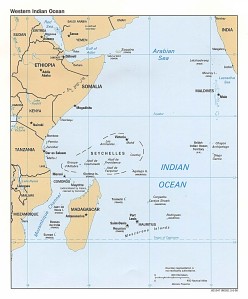Third-Century Indian Coins in Twentieth-Century Ethiopia February 17, 2011
Author: Beach Combing | in : Ancient , trackback
In 1940 a thrilling discovery was made at the Ethiopian monastery of Dabra-Dammo in northern Ethiopia. In the remains of a gold encrusted box in the holy house 104 Indian coins were identified. The coins were extremely valuable: the possibility that a practical joker – perhaps an Italian squaddie – brought these across in 1939 can be pretty much discarded then.
The coins were also consistent among themselves. ‘Five of them were double gold denaries of King Vima Kadphises II, five others were gold denaries of Kaniska, 88 were those of Huviska, and the six latest were gold denaries of Vasudeva I.’
Huviska was succeeded on the throne of the Kushan Empire c. 220 AD by Vasudeva. These coins seem to have been collected – the numbers suggest – in the first years of Vasudeva’s reign when many coins of his predecessor were still in circulation. Again it is worth stressing that in terms of chronology this hoard offers no complications or reasons for suspicion.
In terms of ‘place’ though Beachcombing palls with horror. How in the name of heaven did a collection of valuable coins get from northern India to the foothills of the Mountains of the Moon in northern Ethiopia in the third century of the Christian era? Presumably either an Indian brought them to Ethiopia or an Ethiopian brought them back to his homeland: a middle man is possible but the integrity of the collection suggests that they were carefully kept together.
Just to put this minimally in context the Roman Empire was trading with southern India in the early centuries BC. There is also some evidence (another post another day) that Ethiopians also sailed to southern India and Ceylon by the fifth century AD. But in between this we have no hint that Ethiopians were making their presence felt in the north of the subcontinent. To the best of Beachcombing’s knowledge though there is no other evidence either from this early or this far north: any contrary indication please write, drbeachcombing AT yahoo DOT com. Such finds are a reminder that so much of our history will remain forever hidden to us. How many Viking axeheads are there in New England dirt? How many early Christian inscriptions in Pacific China? How many Hindu Buddhist charms in the Baltic‘s waters? And how many would be recognised as such even in the unlikely event that they were discovered? Beachcombing exhales! Infinite sadness and all that jazz.
So how did an Ethiopian (or an Indian) make his way across the watery wastes. In the sixth century AD Procopius describes Ethiopian vessels: ‘They are not greased with pitch or anything else; the boards are not knocked together by iron nails, but they are tied with ropes’. Not exactly something to give courage to a mariner hoping to traverse the Indian Ocean! Or did they take a land route passing along the Troglodyte shores and by the territories of the Persian Empire?
***
24 Feb 2010: Doug writes in with the following comment: The spice trade to Kerala was well established by the first and second centuries CE with evidence of various trading communities on the coast of both Yemen and Somalia – for example there was a community of St Thomas Christians on Socotra as late as the tenth century – St Thomas Christians being the same sort as have been found in Kerala. There were also Nestorian inspired Christian communities around Mumbai. While utterly unprovable, one could imagine some early Christian pilgrim on his or her way to the Holy land deciding to stop off and visit some of the early Christian communities in Ethiopia … Beachcombing wonders whether Ethiopia already had Christian communities in the third century? P, meanwhile, writes in to state: The finding of a 3rd century hoard of Indian coins in Ethiopia is not that surprising. The Periplus of the Erythraean Sea, written by most estimates in the 1st century by a sea captain perhaps from Alexandria, detailed the trade routes along the coastline from the horn of Africa all the way to India … indicating a flourishing trade. This trade became even more voluminous in the 2nd century as the Roman ships discovered the monsoon winds and the quick route to India across the Arabian Sea. So the outer reaches of a single trade route. A remarkable find, but perhaps not a bizarre one? Thanks to Doug, P and Carlos (who put Beach in touch with the right people)!
28 Feb 2011: Beachcombing wants to rush out this off site comment by Yashawant. ‘1. There are flow of commerce in both directions. Coins of king Ezana of Axum (320-360 CE) were found in India in 1990s. See Paul B. Henze, Layers of Time: A History of Ethiopia, 2000. 2. There were Gymnosophists (naked philosophers) in Ethiopia region, somehow related to their counterparts in India. Apollonius of Tyana, a Pythagorean teacher, who used to be compared with his contemporary Jesus of Nezareth, is said to have visited them, and compared them with Gymnosophists of India’. Thanks again to Carlos who made this possible!
25 June 2011: On marine miracles in the Indian Ocean DB writes in ‘Regarding the boats sewn together. Have you read the Sindbad Voyage by Tim Severin, 1982. ISBN 0 09150560 7 The Sohar, an 80 ft replica of an Arab sailing ship, was sewn together with 400 miles of coconut rope and in 1980 sailed from Oman to Canton in about 7 months (23 Nov 1980 – 11 Jul 1981), in a reenactment of the seven voyages of Sindbad.’ Thanks DB!



